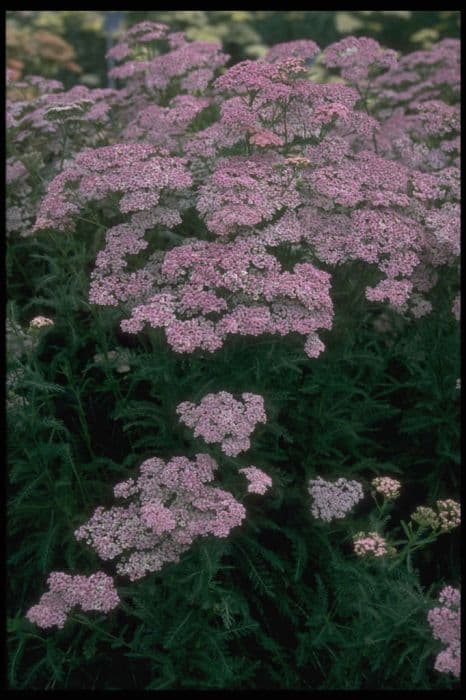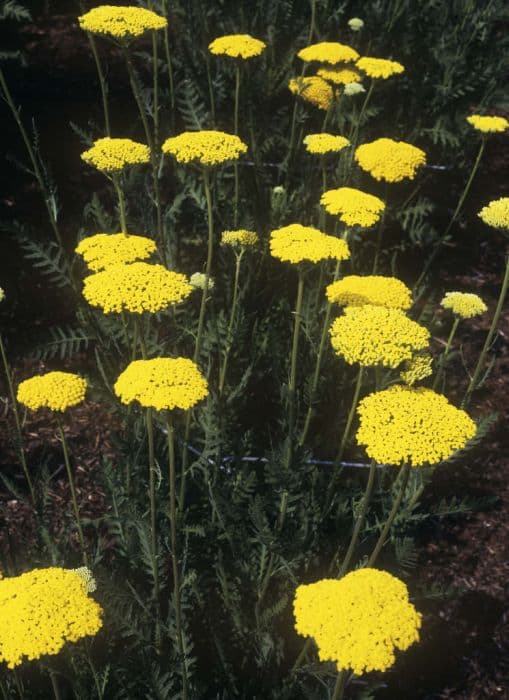Tickseed Coreopsis verticillata Crème Brûlée = 'Crembru' (PBR)
![tickseed [Crème Brûlée]](/_next/image?url=https%3A%2F%2Fplants-admin.emdemapps.com%2Fimages%2Fplants%2F%2Fimages%2F604b566d2e135.png&w=3840&q=75)
ABOUT
Coreopsis verticillata Crème Brûlée, commonly known as tickseed, is a visually striking perennial plant characterized by its vibrant floral display. The tickseed produces an abundance of delicate, daisy-like flowers that boast a unique buttery yellow color with a soft, gradient transition into a warm, orange-tinged center, reminiscent of the caramelized top of the classic Crème Brûlée dessert. Each bloom presents a circle of flat, overlapping petals that surround a central disc, which is typically a darker shade, providing a rich contrast against the softer tones of the petals. These abundant flowers are held aloft on slender, branching stems, which emerge from mounds of fine, thread-like foliage. This airy foliage is deep green in color, and its needle-like appearance offers a delicate texture that complements the bold flowers. The plant's foliage and flowers together create a lush, frothy appearance that adds a light, effervescent quality to garden beds and borders.
About this plant
 Names
NamesFamily
Asteraceae.
Synonyms
Threadleaf Coreopsis, Whorled Tickseed, Needle Tickseed, Fern Tickseed, Thread Leaf Coreopsis, Threadleaf Tickseed, Creme Brulee Tickseed.
Common names
Coreopsis verticillata 'Crembru'
 Toxicity
ToxicityTo humans
The Tickseed, specifically the Coreopsis verticillata 'Crembru', is generally considered non-toxic to humans. There are no commonly reported symptoms of poisoning because it is not known to be poisonous if ingested or handled.
To pets
The Tickseed, including the variety Coreopsis verticillata 'Crembru', is also not known to be toxic to pets. It is generally regarded as safe, and there are no well-documented symptoms associated with its ingestion by animals such as cats and dogs.
 Characteristics
CharacteristicsLife cycle
Perennials
Foliage type
Deciduous
Color of leaves
Green
Flower color
Yellow
Height
1-2 feet (30-60 cm)
Spread
1-2 feet (30-60 cm)
Plant type
Herb
Hardiness zones
5
Native area
North America
Benefits
 General Benefits
General Benefits- Attracts pollinators: Coreopsis verticillata 'Creme Brulee' is known for attracting bees, butterflies, and other beneficial insects to the garden.
- Drought tolerance: Once established, this variety of tickseed is quite drought-tolerant, making it suitable for xeriscaping and low-water gardens.
- Long blooming period: It offers a long blooming season from early summer into fall, providing consistent color in the landscape.
- Low maintenance: It requires minimal care, thriving in a variety of soil types and conditions and typically does not need frequent fertilization or watering.
- Deer resistance: Often considered deer-resistant, making it a good choice for gardens prone to deer browsing.
- Easy to propagate: Tickseed plants can be easily propagated by division, allowing gardeners to expand their garden or share with others.
 Medical Properties
Medical PropertiesThis plant is not used for medical purposes.
 Air-purifying Qualities
Air-purifying QualitiesThis plant is not specifically known for air purifying qualities.
 Other Uses
Other Uses- Natural Fabric Dye: The flowers of Coreopsis verticillata can be used to produce a range of yellow, orange, and brown dyes for natural fiber fabrics.
- Photography: The distinct colors of the Coreopsis verticillata flowers can be used in the composition of garden photography to enhance the aesthetic appeal.
- Garden Themed Artwork: Pressed or dried flowers of the Coreopsis verticillata can be used in crafting unique artwork, like creating botanical prints or mixed media compositions.
- Educational Tool: Coreopsis verticillata can be a source of learning for botany students studying plant structures, lifecycles, and ecology, by observing its growth and pollinator interactions.
- Flower Arranging: The bright blooms of the Coreopsis verticillata make them a popular choice for fresh-cut or dried arrangements in floristry.
- Culinary Decoration: The petals of Coreopsis verticillata, though not commonly consumed, could be used to add color to salads or as an edible decoration on desserts and dishes.
- Butterfly Gardening: Coreopsis verticillata is known to attract butterflies, and can therefore be used to create a butterfly garden to support local biodiversity.
- Soil Erosion Control: Due to its dense and fibrous root system, Coreopsis verticillata can be planted to help stabilize soil and prevent erosion on slopes.
- Garden Design Themes: Coreopsis verticillata can be used in 'hot' themed gardens due to its warm-toned flowers, paired with plants like red salvia and orange marigolds.
- Children’s Sensory Gardens: The soft texture of the Coreopsis verticillata foliage and bright color of the flowers make it suitable for sensory gardens designed for children to explore different textures and colors.
Interesting Facts
 Feng Shui
Feng ShuiThe plant Tickseed is not used in Feng Shui practice.
 Zodiac Sign Compitability
Zodiac Sign CompitabilityThe plant Tickseed is not used in astrology practice.
 Plant Symbolism
Plant Symbolism- Optimism: Coreopsis, commonly referred to as tickseed, often symbolizes hope and positivity, as its bright flowers bring cheerfulness to gardens.
- Love: The vibrant blooms of tickseed can also represent love and affection, giving them a place in romantic bouquets.
- Good Fortune: Tickseed is sometimes associated with good luck due to its appealing nature and the belief that it can inspire a positive outlook.
 Water
WaterThread leaf coreopsis should be watered regularly to maintain moist but not waterlogged soil, especially during its first growing season to establish a deep, extensive root system. Once established, it is fairly drought tolerant and requires less frequent watering. Aim for about 1 inch of water per week, either from rainfall or supplemental watering. During hot and dry periods, you may need to water twice a week, providing about 0.5 gallons per plant each time. Overwatering or poorly drained soil can lead to root rot, so ensure the soil drains well.
 Light
LightThread leaf coreopsis thrives best in full sun, which means it should receive at least 6 to 8 hours of direct sunlight daily. The plant can tolerate light shade, but too much shade will result in fewer flowers and a leggy growth habit. The ideal spot for planting thread leaf coreopsis is in an area where it can bask in the sun's rays without any obstruction from larger plants or structures.
 Temperature
TemperatureThread leaf coreopsis is hardy and can tolerate a wide range of temperatures, typically from about -30°F to 100°F. The ideal growth temperatures are between 60°F and 75°F. It can survive light frosts, but prolonged exposure to temperatures below freezing will cause the plant to die back in winter, returning in the spring if the root system is well-established and insulated.
 Pruning
PruningPrune thread leaf coreopsis to promote vigorous growth and increase flower production. Deadheading, or removing spent flowers, will encourage the plant to produce more blooms. Cut the plants back by about one-third in midsummer if flowering diminishes or the plants look tired. The best time to prune is after the plant has finished its first flush of blooming, usually in late summer or early fall.
 Cleaning
CleaningAs needed
 Soil
SoilThreadleaf Coreopsis thrives in well-draining, fertile soil with a pH ranging from 5.8 to 6.8. A good mix can be created with garden soil, compost, and some sand to enhance drainage. Avoid soil that holds too much moisture as it can lead to root rot.
 Repotting
RepottingThreadleaf Coreopsis, being a perennial, does not typically require frequent repotting. It should be repotted or divided every 2-3 years to maintain vigor and to control its spread in the garden.
 Humidity & Misting
Humidity & MistingThreadleaf Coreopsis prefers moderate to low humidity conditions and is quite tolerant of dry air, making it suitable for a wide range of climates without needing to significantly alter environmental humidity levels.
 Suitable locations
Suitable locationsIndoor
Ensure bright light, well-draining soil, and moderate watering.
Outdoor
Plant in full sun, well-draining soil, and space 12-18 inches apart.
Hardiness zone
3-9 USDA
 Life cycle
Life cycleCoreopsis verticillata Crème Brûlée, commonly known as Threadleaf Coreopsis or Whorled Coreopsis, starts its life cycle from a seed, which when sown, germinates into a small seedling. As it grows, it develops a fibrous root system and fine, feathery foliage characteristic of the cultivar. It enters the vegetative stage wherein it forms a mound of delicate, needle-like leaves and becomes hardy as it matures. The plant then progresses to the flowering stage in early to mid-summer when it produces numerous small, daisy-like flowers with a creamy yellow hue that attract pollinators. After pollination, it sets seeds later in the season, which can self-sow, renewing the life cycle. Once established, this perennial enters a period of dormancy during the winter, to re-emerge and grow again in the spring.
 Propogation
PropogationPropogation time
Early Spring
Coreopsis verticillata 'Crème Brûlée' is often propagated by division, which is commonly done in the spring or early fall. To propagate by division, first, the gardener should water the plant well to ensure the soil is moist, which facilitates easier separation of the root ball. Afterward, the plant should be carefully dug up with a shovel, ensuring a generous amount of soil is kept around the roots. Using either hands or a gardening tool like a knife, the root ball should then be divided into smaller sections, each with several shoots and a healthy portion of roots. The divisions can be replanted at the same depth they were originally growing at, spacing them about 15 to 18 inches (approximately 38 to 45 centimeters) apart to allow for adequate growth. After replanting, the divisions should be watered thoroughly to help establish them in their new locations.









